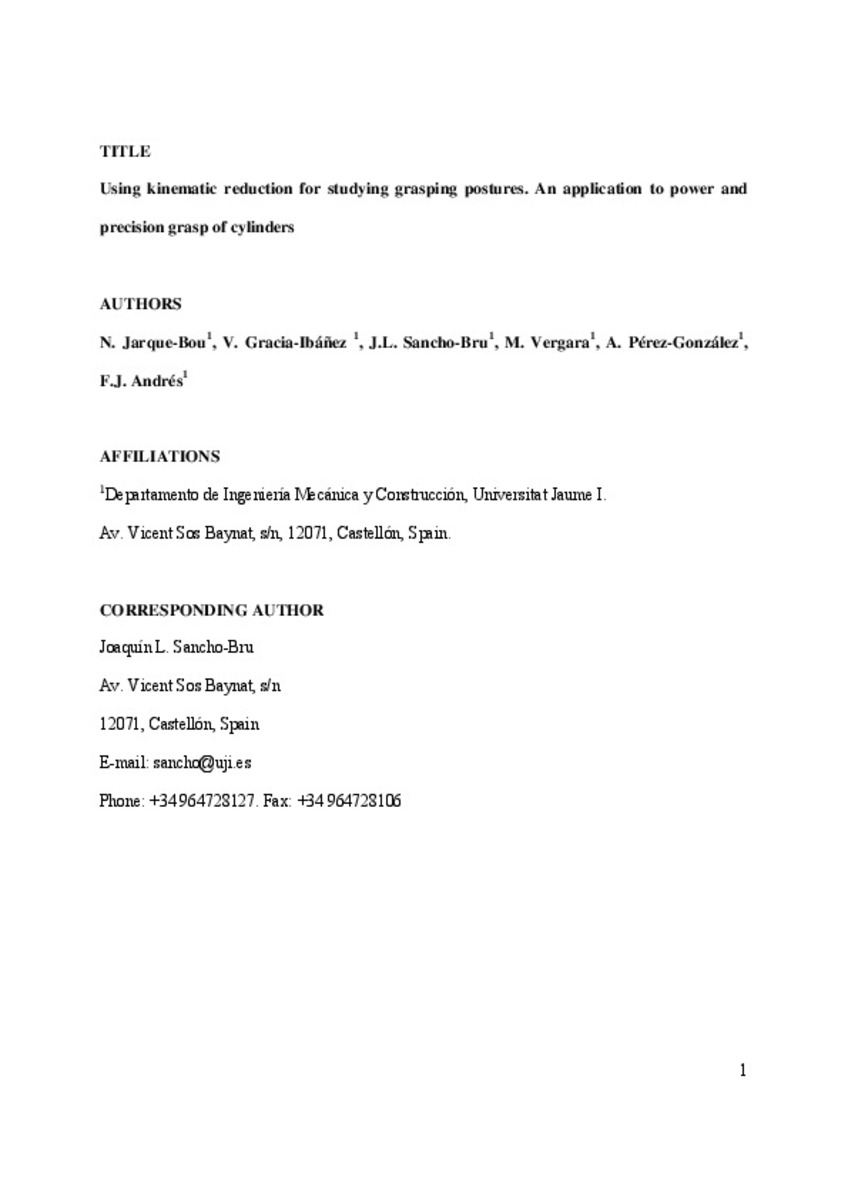Mostrar el registro sencillo del ítem
Using kinematic reduction for studying grasping postures. An application to power and precision grasp of cylinders
| dc.contributor.author | Jarque-Bou, Néstor J | |
| dc.contributor.author | Gracia-Ibáñez, Verónica | |
| dc.contributor.author | Sancho-Bru, Joaquin L. | |
| dc.contributor.author | Vergara, Margarita | |
| dc.contributor.author | Pérez-González, Antonio | |
| dc.contributor.author | Andres-Esperanza, Javier | |
| dc.date.accessioned | 2016-04-28T07:39:25Z | |
| dc.date.available | 2016-04-28T07:39:25Z | |
| dc.date.issued | 2016 | |
| dc.identifier.citation | JARQUE-BOU, N., et al. Using kinematic reduction for studying grasping postures. An application to power and precision grasp of cylinders. Applied Ergonomics, 2016, vol. 56, p. 52-61 | ca_CA |
| dc.identifier.issn | 0003-6870 | |
| dc.identifier.issn | 1872-9126 | |
| dc.identifier.uri | http://hdl.handle.net/10234/159012 | |
| dc.description.abstract | The kinematic analysis of human grasping is challenging because of the high number of degrees of freedom involved. The use of principal component and factorial analyses is proposed in the present study to reduce the hand kinematics dimensionality in the analysis of posture for ergonomic purposes, allowing for a comprehensive study without losing accuracy while also enabling velocity and acceleration analyses to be performed. A laboratory study was designed to analyse the effect of weight and diameter in the grasping posture for cylinders. This study measured the hand posture from six subjects when transporting cylinders of different weights and diameters with precision and power grasps. The hand posture was measured using a Vicon® motion-tracking system, and the principal component analysis was applied to reduce the kinematics dimensionality. Different ANOVAs were performed on the reduced kinematic variables to check the effect of weight and diameter of the cylinders, as well as that of the subject. The results show that the original twenty-three degrees of freedom of the hand were reduced to five, which were identified as digit arching, closeness, palmar arching, finger adduction and thumb opposition. Both cylinder diameter and weight significantly affected the precision grasping posture: diameter affects closeness, palmar arching and opposition, while weight affects digit arching, palmar arching and closeness. The power-grasping posture was mainly affected by the cylinder diameter, through digit arching, closeness and opposition. The grasping posture was largely affected by the subject factor and this effect couldn't be attributed only to hand size. In conclusion, this kinematic reduction allowed identifying the effect of the diameter and weight of the cylinders in a comprehensive way, being diameter more important than weight. | ca_CA |
| dc.description.sponsorShip | We are grateful to the Universitat Jaume I for financial support through project P1·1B2013-33, and the Spanish Ministry of Research and Innovation and the EU (FEDER funds) jointly through projects DPI2010-18177 and DPI2014-52095-P. | |
| dc.format.extent | 10 p. | ca_CA |
| dc.format.mimetype | application/pdf | ca_CA |
| dc.language.iso | eng | ca_CA |
| dc.publisher | Elsevier | ca_CA |
| dc.relation.isPartOf | Applied Ergonomics, 2016, vol. 56 | ca_CA |
| dc.rights | © 2016 Elsevier Ltd and The Ergonomics Society | ca_CA |
| dc.rights.uri | http://rightsstatements.org/vocab/InC/1.0/ | * |
| dc.subject | hand posture | ca_CA |
| dc.subject | principal components analysis | ca_CA |
| dc.subject | cylindrical objects | ca_CA |
| dc.subject | grasp analysis | ca_CA |
| dc.title | Using kinematic reduction for studying grasping postures. An application to power and precision grasp of cylinders | ca_CA |
| dc.type | info:eu-repo/semantics/article | ca_CA |
| dc.identifier.doi | http://dx.doi.org/10.1016/j.apergo.2016.03.003 | |
| dc.rights.accessRights | info:eu-repo/semantics/openAccess | ca_CA |
| dc.relation.publisherVersion | http://www.sciencedirect.com/science/article/pii/S0003687016300370?np=y | ca_CA |
Ficheros en el ítem
Este ítem aparece en la(s) siguiente(s) colección(ones)
-
EMC_Articles [807]







